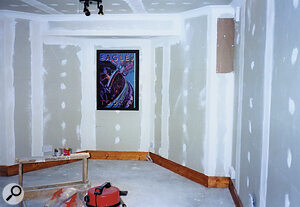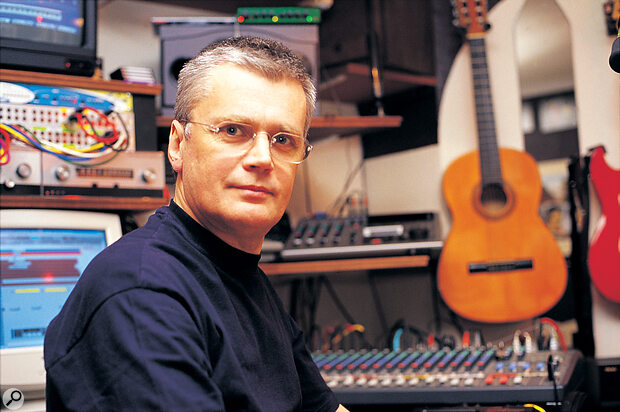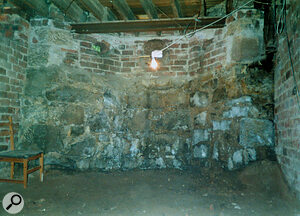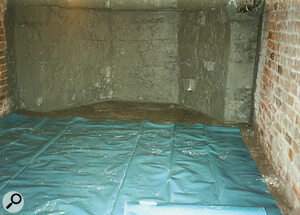<!‑‑image‑>When it comes to developing a home studio, many people have to resort to sharing space in a spare bedroom of their house. Such is the addictive nature of the activity, however, that the equipment collection can quickly outgrow the available room necessitating a more radical solution (preferably one that doesn't involve moving your loved ones into the garden shed!). Just such a dilemma faced Iain (Ike) Grant a few years ago. As described more fully below, Ike's solution to his space problem showed admirable commitment to the recording cause. The resulting well‑stocked basement recording room provides him with an excellent working environment, but took a considerable amount of time and effort to realise.
Despite having played guitar in various bands for many years, Ike's interest in music technology is something that has only really developed in the last ten years or so. When he moved into his present ground‑floor flat in a Glasgow tenement, his recording equipment had to fit into a corner of the room from which he ran his day job. By profession, Ike is a chartered quantity surveyor and, until quite recently, worked from home as a consultant, with his office in a spare bedroom. "As I bought more equipment, the space became less manageable, and despite a change in my job circumstances that meant I was working less and less from home, I really wanted a dedicated room for the studio equipment."
Going Underground
 The Dell PC and main processing rack (left). The monitor on the top shelf makes operating the Roland S760 sampler much more enjoyable.
The Dell PC and main processing rack (left). The monitor on the top shelf makes operating the Roland S760 sampler much more enjoyable.
Ike's solution to his space problem was to go underground. As he explains, beneath his ground floor flat was an unused basement area. "The basement was basically an empty space, apart from having been used as a dumping ground by various builders carrying out maintenance work over the last 100 years or so. It had an uneven dirt floor, rough brick walls and an open joist ceiling." The condition of the space was not, however, the most immediate problem, as the basement was communal property, owned by all the residents in the block. "I did the conversion on a very commercial basis. Before getting too deeply involved, I took some advice as to how much the conversion of the basement might add to the value of my property, bearing in mind that it would essentially be a series of rooms that had no natural light and could therefore only be classed as storage space if I ever came to sell up. This was useful, as it gave me a figure in financial terms so I could justify pursuing the idea and know that I would see some return for any expenditure involved."
<!‑‑image‑>With a budget in mind, Ike started the process of approaching the other occupants of the block. "The legal side seemed to take forever. Everyone was very co‑operative, but just the fact of getting all the paperwork through the various solicitors involved made it a slow process. It took about two years to get to a stage where I could actually start to do any refurbishment work on the space."
<!‑‑image‑>Ike's professional experience put him in a good position to plan the actual building work but even so, this stage took a further year. "I did the design myself, and the work was carried out partly by contractors hired as required and partly by myself. For example, I did all the wiring and put in the stairs that come down from the main flat. The speed of progress was controlled by how quickly I could get the cash together and the personal time I had to do the work. Doreen's son [Doreen is Ike's partner] and myself did a 'cut and fill' job to get the floor level. It was quite a job to achieve a flat surface. The floor was then given a six‑inch solid concrete base. The walls and ceiling are metal studs with insulation quilt, lined with double plasterboard. The doors have solid cores. Our bedroom is directly above the studio and Doreen tells me the noise levels are not too bad! Being a quantity surveyor obviously helped with the building work and, from a soundproofing point of view, doing a basement conversion is obviously easier than doing an attic. In the latter case, it would be so much more difficult to deal with sound leakage through the floor."
<!‑‑image‑><!‑‑image‑><!‑‑image‑><h3>Cover Me</h3>
Ike has a long‑standing love of music, initiated by growing up listening to the records of bands like the Beatles, the Rolling Stones, the Hollies and the Kinks. This, in turn, led to an interest in the guitar. "I started playing in a band context in the '60s. When I could play a few chords on a guitar, I got asked by some friends to join their band (called the Topkats, which somehow seemed like a very cool name at the time!) and I played a pretty poor rhythm guitar through a set that consisted mainly of covers of stuff by our favourite groups. Singing has never been my strong point, so I couldn't really contribute vocally."
Ike first became interested in music technology during the late 1980s. "During the late '80s and early '90s, some friends and I played in a band called the Wrinklies (this was never a cool name, but was forced upon us by our various children, as we were all the wrong side of 40!). The line‑up didn't feature a drummer, so for a while we used a truly awful drum machine built into a keyboard. Eventually we bought an Alesis SR16, and I was the one who learned to program it. We had quite a big set of material, again mainly covers of classic rock and pop tunes, so I soon used up all the internal memory and we ended up buying a second SR16 just so I could program more songs! This seems so ridiculous now, but it was an economical and effective answer at the time for someone who had no proper knowledge of sequencing, nor any sequencing facilities. I just wonder how many SR16s we would have bought by now if I had not gone down the Cubase route. You could imagine the comments... 'Wow, you've got two vans to carry all the band's equipment'. 'Yes, we needed the second one for all the SR16s!'"
Ike's next purchase was a Yamaha MDF (MIDI Data Filer) that provided extra storage for drum and keyboard sequences when the band played live. This was soon followed by an Atari, and then a PC with an early version of Cubase. "At this time, I had a Toshiba portable computer that went everywhere with me — to band practices and to gigs. It was always a source of interest around 1990 when we appeared at a gig and used a computer on stage. Playing live you might imagine it would be a bit suspect, but once it was set up, we never had a problem."
As the band's interest in sequencing to support live performance grew, some additional pieces of 'recording' equipment were added to Ike's collection. "I started to expand what Cubase controlled for us when playing live. For example, my guitar signal was passed through a Yamaha FX770 guitar multi‑effects unit, and I set up Cubase to deal with all the effects changes needed within and between songs. As someone who considers himself an average guitar player at best, it saved me having to worry about a collection of foot pedals and remembering what setting was needed when. We did the same thing with the Roland S760 sampler, which we also used to use live, mainly for drum samples, all programmed in Cubase."
Information Overload
<!‑‑image‑>When the band decided to call it a day, Ike's interest in recording technology began to take over. "I started reading Sound On Sound during 1994. That really got me hooked, and I began to buy other pieces of equipment on a fairly regular basis." This growing interest, and expanding equipment collection, is what eventually led to Ike's space problem and the basement development.
While Cubase has been his sequencer of choice for MIDI for some time, Ike has been through a number of setups for recording audio. "I used to have the Tascam cassette Portastudio sync'd up to Cubase, but the cassette format is limited and you lose one track to timecode. Sometimes the Tascam could be really tricky to get sync'd up, too, so I wanted something more reliable and more flexible. I now absolutely love the Yamaha MD4S four‑track Minidisc recorder. I've really got to grips with it; all the editing functions, bouncing tracks to a new song and so on. I just wish it was an eight‑track and that I had a simple way of backing up data."
Of his more recent purchases, Ike is particularly enthusiastic about a piece of equipment that doesn't actually make any noise at all. "One of the most useful things I've installed recently is the patchbay. You start by thinking that you just set the equipment up and plug it in and then get on with it. However, you soon realise how often you need to move things about, and that's a real problem, digging around at the back of the kit with a torch. The patchbay was a revelation, as it made things so much easier and more flexible. I bought a second one a couple of months ago so I could get all the kit hooked up in that way.
"I'm also really pleased with the Johnson J‑station. I can now record guitars without disturbing anyone else in the house, and the range of amp models just gives you such a variety of sounds. I bought the J‑Station rather than a Line 6 POD after reading Dave Lockwood's review in SOS. I needed something that gave me some bass amp models as well, as I do some bass guitar recording."
One problem Ike finds with his recording hobby will strike a chord with many SOS readers. "There just aren't enough hours in the day. While I've got a system that works and there are certain bits of the gear that I know really well, there are other areas where I know I'm only scratching the surface. There is just so much to learn, and sometimes there is a danger of information overload. For example, I use Cubase mainly for MIDI sequencing, but when I upgraded the PC a couple of months ago it was mainly so that I could move up to Cubase v.5. I use all the MIDI editing facilities a lot but, as yet, I've hardly touched on its audio capabilities. I'm almost stopping myself from doing this, for fear of getting sucked in. I feel I can handle the way I have things working at present and I'm getting some stuff recorded. If I start to explore the audio side of Cubase, I probably wouldn't get any real recording done for another six months!"
The other problem Ike struggles with is knowing when a recording is actually finished. "I can never finish a song, I just work on it and work on it. I want to move on to the next thing but can never quite box off the previous song and label it as finished. I'm sure this is something other home studio owners must face. I guess if I was in a commercial studio and was paying by the hour, I'd be a bit more focused!"
Keeping It In The Family
Despite spending many years playing in bands, Ike actually likes to work on his own in his studio. "I'm probably very selfish when it comes to recording, and I really like being able to do things my own way. I do write some of my own stuff, but I also love to record other people's songs. There is just so much good material out there. There is also a lot that can be learned by doing this and perhaps trying to put your own stamp on it."
Until Ike can spend some time getting to grips with hard‑disk recording, his present working process is based around Cubase for the MIDI parts of his song arrangements, with audio being recorded onto the Yamaha MD4S digital four‑track. "The MD4 is acting as the master and Cubase is sync'd up to that. It's pretty straightforward and, of course, only gives four tracks, but I'm so comfortable with editing and bouncing on the MD4 that I'm happy to stick with it for now." On the MIDI side, however, Ike does get involved with all sorts of mix automation. "One of the major uses I have for the sequencer is to control the parameters of most of my outboard gear in real time — I really do find this incredibly useful, especially since it means that I don't have to remember all the settings used. They're simply programmed into the sequence and then the correct parameters are called up at the start of each song, with any changes being made along the way."
Given Ike's considerable experience in programming the SR16, it's not surprising that songs tend to start with the drum track. A chord base is usually added, followed by bass guitar, and then some rhythm guitar. "I'm perhaps a bit limited for sound sources otherwise, so the S760 sampler does a useful job on that front. The sampler is used as much as a sound module as anything else. I've got some good drum samples and a nice Hammond B3 set that I use a lot. I've also got a TV screen hooked up to it, so setting it up is much easier than just working with the small, built‑in display.
"Everything is routed through the Yamaha M200 mixer. I used to have a smaller Mackie mixer and I thought the EQ on that was fantastic. In comparison, the EQ is very limited on this desk, but I just wanted the number of channels."
Vocals are usually the last thing to be added. "I might even sing a vocal myself, although I'm not a great singer. I bought the Antares Autotune rack unit recently, and it is just a stunning piece of equipment. Just punch in the right key, give me 20 or so takes, and I can put something half‑decent together. I wish I'd had one of these in the '60s — I might have made a living at this!" In order to overcome the vocal barrier, Ike has now recruited his daughters, Jenny and Kim. "Both of them have now been in and done some recording and it's been great to see their reaction to hearing their own performance. I think both of them get quite a kick out of it, and they have good singing voices. I'd like to encourage them and get them to do some more stuff." Ike records several vocal takes to the MD4 and then uses the cut‑and‑paste functions to compile the best from each. "I also use the Digitech Vocalist to add a little harmony to the lead vocal in places. As long as you keep the levels reasonable, the Vocalist does a nice job."
Despite now having some ten years experience of working with music technology, in recording terms Ike still thinks of himself as a novice. "Lots of what I do is trial and error. There is so much more to the recording process than just sticking a mic in front of someone. I've still got a lot to learn and this is a big part of the fascination of the recording process for me; it's what will keep me going into the future. It doesn't matter what equipment you have available, there's always something new to discover about it. I'll get there, but my main restriction is time. Despite the pull of the studio, I do like to make sure I see my family on a regular basis!"
Main Equipment
 Three stages in the making of the studio.
Three stages in the making of the studio.
- Dell Pentium III PC with SoundBlaster Live soundcard
- Steinberg Cubase VST 5
- Yamaha MD4S Minidisc four–track
- Johnson J‑Station modelling guitar preamp
- Roland S760 sampler
- Lots of guitars!
Ike's Equipment
 Ike's basement room, finished and complete with comfy chairs!
Ike's basement room, finished and complete with comfy chairs!COMPUTER HARDWARE/SOFTWARE
- Dell 1GHz Pentium III PC with 128Mb RAM and internal CD writer
- Steinberg Cubase VST 5 sequencing software
- SoundBlaster Live soundcard
ELECTRONIC SOUND SOURCES
- Alesis SR16 drum machine
- Roland JV35 keyboard
- Roland S760 sampler (with Syquest drive for backup)
- Yamaha MU10 sound module
OUTBOARD
- Alesis 3630 compressor/limiter
- Behringer Ultrafex II enhancer
- Behringer UltraPatch Pro Model PX2000 patchbay (x2)
- Cutec GS2200 graphic equaliser
- Digitech Studio Quad multi‑effects
- Digitech Studio Vocalist II
- Johnson J‑Station modelling guitar preamp
- Joe Meek VC3Q preamp/compressor/EQ
- Yamaha FX770 guitar effects unit
- Yamaha REV100 digital reverb unit
RECORDING
- Tascam 424 4‑track cassette Portastudio
- Yamaha MD4S Minidisc 4‑track recorder
- Yamaha M200 24‑channel mixer
GUITARS
- Eko Ranger 6‑string Jumbo electro‑acoustic (1965)
- Fender USA Stratocaster (1997)
- Hagstrom/Futurama III electric: "This is from the early '60s, I think. It was originally painted in emulsion when I purchased it second‑hand for £8, but it's now been restored and looks great."
- Hohner Jack headless bass guitar (1990)
- Ovation Pinnacle 6‑string electro‑acoustic (1990)
- Schecter Diamond Series TSH‑1 semi‑hollow electric (1999)
- Nylon‑strung acoustic
AMPLIFIERS & MONITORS
- Fender Princeton Chorus amplifier
- Peavey KB300 amplifier
- Peavey KB100 amplifier
- Samson Servo 170 studio monitor amplifier
- Spirit Absolute 2 nearfield monitors
OTHER
- Leak Stereo 30 amp and Leak tuner
- Pioneer hi‑fi speakers
- Rock‑ola Juke Box: "I've owned a couple of juke boxes. This needed some work, but we now have the selection box up in the kitchen, so a 10p piece gets us some music up there!"




